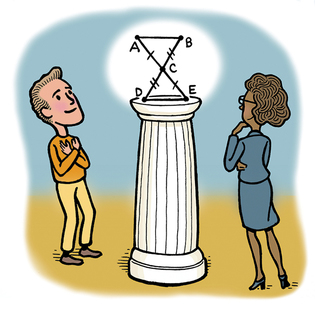 loading
loading
FindingsThe results are beautifulLooking for the aesthetic value in mathematical proofs.  Gregory NemecView full imageStefan Steinerberger, assistant professor of mathematics, would like you to know that mathematicians, like artists, are driven by imagination, and that mathematics possesses intrinsic beauty. And he has some data to prove his point. After musing to his students that one particular proof was like a good Schubert sonata, Steinerberger decided to find out if the beauty he sees in math might also be experienced by those with limited mathematical knowledge. To explore his question, Steinerberger partnered with cognitive psychologist Samuel Johnson ’17PhD (now at the University of Bath). Given that the relationship between math and music has long been noted, they added visual arts to their experiment. “We wanted to see,” Steinerberger says, “if our human sense of aesthetics allows us to see math structures as beautiful, or do those judgments come from being socialized as a mathematician?” The results were published in the journal Cognition. The pair recruited 300 participants from an online crowdsourcing platform; most had college degrees, but only a few had taken high-level math. They were presented with explanations of four mathematical proofs, and then each was given a task. One group was asked to match each of the four math proofs to one of four nineteenth-century romantic landscapes, based on how aesthetically similar they found them. A different group was asked to compare the same four proofs to solo piano works by Bach, Beethoven, Schubert, and Shostakovich. A third group was asked to rate each painting and math proof for nine criteria related to aesthetic judgment: seriousness, universality, profundity, novelty, clarity, simplicity, elegance, intricacy, and sophistication. Overall, the results showed significant consensus in comparing mathematical arguments to art works, and some consensus about the similarities between classical piano music and mathematics. “We have shown,” Steinerberger says, “that people find basic logical concepts to have aesthetic value.” The results, he says, raise many areas for further research, including how these effects might translate across cultures, and whether the findings could be used by educators to encourage the study of math for its sheer beauty.
The comment period has expired.
|
|